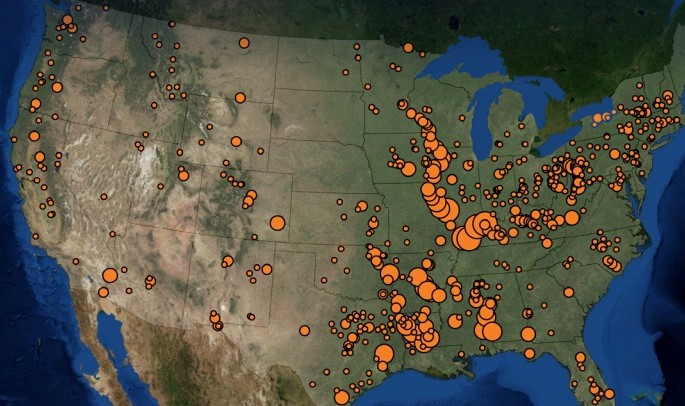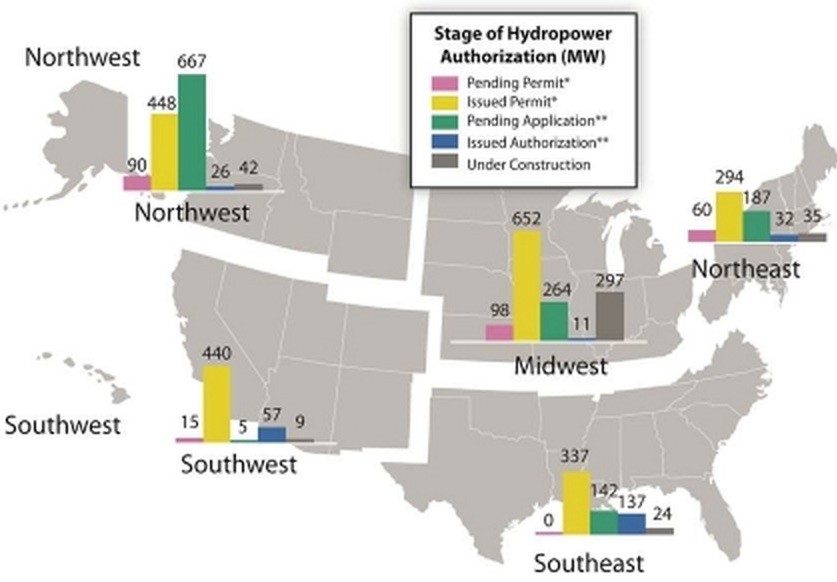WASHINGTON, June 2, 2015 -- Hydropower from dams across the country provided a third of the nation’s electricity in the 1940s. Today those dams still generate 7 percent of U.S. electricity, enough to power more than 20 million homes. This makes hydropower the largest single source of renewable energy, with wind at 5 percent and solar still just 1 percent.
But there’s vast untapped potential in hydropower that could be unleashed soon, thanks in part to the rapid growth of wind and solar. And if the EPA’s proposed Clean Power Plan to limit CO2 emissions from coal power plants survives legal challenges, the shift to wind, solar and hydropower could accelerate significantly.
The U.S. Department of Energy calls for doubling hydropower’s contribution to 15 percent by 2030. To get there, DOE research is focused on improving turbine technology at existing dam sites, adding turbines to non-powered dams, and developing new technologies to generate electricity from water and sewer lines, open rivers and streams, and ocean waves, tides and currents.
DOE’s first-ever Hydropower Market Report released in April shows that despite hydropower’s slow growth of just 1.48 gigawatts (GW) from 2005 to 2013,
- “The U.S. hydropower fleet contains 2,198 active plants with a total capacity of 79.64 GW, approximately 7 percent of all U.S. generating capacity.”
- “Half of the installed capacity is located in three states (Washington, California, and Oregon).”
- “Federal agencies (Army Corps of Engineers, Bureau of Reclamation, and the Tennessee Valley Authority) own nearly half of the installed hydropower capacity. The 176 plants they own account for 49 percent of the capacity but only 8 percent of the plants.”
- “Publicly owned utilities, state agencies, and electric cooperatives own an additional 24 percent of capacity. The remaining quarter – which corresponds to 62 percent of the plants – belongs to private owners.”
DOE research is already generating benefits: “DOE’s assessments of wave and tidal energy resources show the potential to generate 1,420 terawatt-hours of electricity each year off U.S. coasts. (A terawatt is a trillion watts.) DOE is supporting testing and deployment of the nation’s first wave and tidal energy projects, and launched the first federally funded hydropower facility upgrades in more than 20 years, increasing generation by 7 to 30 percent at seven large hydropower projects. DOE also helped develop ‘fish-friendly’ hydropower turbines that improve fish survival rates to more than 98 percent without sacrificing efficiency.”
Top 600 U.S. Non-Powered Dams with Potential Capacity Greater than 1 megawatt (MW)
(smallest dot 1 MW capacity, largest 243 to 496 MW)

Source: U.S. Department of Energy Water Power Program.
One challenge facing renewables in Congress has been that renewable energy has been unevenly distributed across the country, with ethanol production in the Midwest, the wind corridor stretching from Texas to the Dakotas, hydropower in the Northwest and Northeast, and relatively little renewable activity in the South and Southeast.
As reported in our May 20 Agri-Pulse newsletter, DOE’s Enabling Wind Power Nationwide report showed that “there is tremendous potential to expand production across all 50 states by embracing taller wind turbines, larger rotors, and other technical innovations.”
Similarly, DOE analysis shows that hydropower is a resource available to most states through tapping non-power dams, rivers and streams, and the oceans. The New Stream-reach Development Assessment from DOE’s Oak Ridge National Laboratory pinpoints more than 65 gigawatts of untapped sustainable hydropower potential in U.S. rivers and streams.
Developing marine and hydrokinetic (MHK) energy generated from highly forecastable ocean waves, tides and currents should also generate broad support in Congress because more than 50 percent of the U.S. population lives within 50 miles of America’s coastlines.
So the long pause in new hydropower could be ending. New projects are being built, like the 24-megawatt (MW) hydroelectric plant that the East Texas Electric Cooperative is building to power about 12,000 homes and generate about $1 million annually for the nearby city of Houston. The plant, scheduled to go online in 2018, will generate electricity at a competitive 6 cents per kwh power from water already running through the Trinity River and into Lake Livingston.
New Hydropower Projects

Source: Energy Department Hydropower Market Report April 2015.
In last month’s Senate Energy Committee hearing on proposed new energy legislation including S. 1236, the Hydropower Improvement Act from Committee Chair Lisa Murkowski, R-Alaska, American Public Power Association CEO Susan Kelly testified that utilities increasingly will need hydropower’s reliability to offset the variability of wind and solar as more coal plants are shut down.
Kelly concluded that, “Making full use of the nation’s hydropower resources is key to ensuring that the nation’s grid remains reliable and resilient, and that utilities can meet emission reduction goals.” She continued: “Hydropower is a source of emissions-free base-load power which, unlike variable renewable resources, is generally available 24/7. Moreover, hydropower’s ‘black start’ capability makes it highly valuable from the standpoint of cyber and physical security. In instances of outages or disruptions to the grid, hydropower units can cycle back on quickly and help support full power restoration.”
In the House Energy and Commerce Committee’s Hydropower Regulatory Modernization hearing on companion legislation, Energy and Power Subcommittee Ranking Member Frank Pallone, D-N.J., objected to streamlining hydropower permitting. Saying that America’s rivers “belong to all Americans, not just those who sell or buy the power generated,” Pallone charged that the Republicans’ proposed legislation “undermines the key provisions of current law that exist to conserve our natural resources and protected areas and ensure a balanced approach to the use of our nation’s rivers.” But Committee Chair Fred Upton, R-Mich., insisted on the need for “a more timely and certain permitting process for hydroelectric power” to unleash hydropower’s “economic, energy security, and environmental benefits.”
One remaining challenge is the California drought which has cut back sharply on hydropower as part of the region’s energy mix. Environmentalists have long fought the addition of new dams, much to the dismay of agriculturalists and hydropower advocates. But as hydropower, wind and solar resources are added across the country along with transmission line and grid improvements to ship power to where it’s needed, hydropower is expected to play an increasingly important role nationally in keeping the lights on and costs down coast to coast.
In its 2015 Resources Assessment released May 7, the California Independent System Operator Corp., which manages electricity supplies for the state, addresses the “decrease in hydro power supply from the continuing drought” and concludes that water shortages not only reduce hydropower but also threaten electricity supply from natural gas plants which rely on water for cooling. But the report forecasts that during summer peak demand, supply will remain adequate “due to significant renewable generation additions, sufficient imports, and moderate peak demand growth.”
The California report points out that with only 58 percent of average precipitation and 4 percent of April 1 average snowpack water content, “The impacts of the continuing drought are increasing in severity as California moves into the drought’s fourth year.” Yet the report concludes that the potential loss of as much as 2,733 MW of hydropower capacity will be offset by 2,328 MW of renewable power capacity added in California over the past year. Of this new generation, “approximately 96 percent is solar, 3.4 percent is wind, and 0.6 percent is biogas.” One example of recently added solar power is California’s new 550-MW Desert Sunlight Solar Farm.
#30
For more news, go to: www.Agri-Pulse.com
